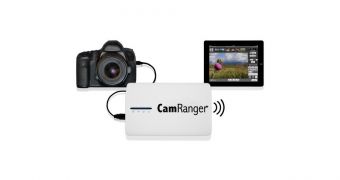CamRanger LLC has just announced that a new firmware version for its CamRanger wireless transmitter is now available for download, adding a few new highly requested tethering features.
The new firmware, version 6, now allows you to share the images captured using either the camera or an iPhon, iPad or Mac with your friends, partners or co-workers via the new CamRanger Share app available for iOS, OS X and Windows platforms (Android support coming soon).
Furthermore, if you choose to watermark your photos or videos, everyone that watches them using the CamRanger Share app will also see the watermarks on their device.
While until now CamRanger could only create its own Wi-Fi network to share images, the new firmware build gives you the possibility to bridge into an existing Wi-Fi network to extend your network range.
Besides that, this version is required if you want to use CamRanger with the new PT Hub and MP-360, which allows you to easily tilt or pan the camera from within the application.
For those of you who haven't heard about CamRanger, you should know that this small transmitter allows you to wirelessly control your digital SLR camera from a PC, Mac, iOS or Android device giving you full control over the camera's options.
With CamRanger, you will be able to remotely access all the features of your camera, including: shutter speed, aperture, ISO, white balance, metering, photo capture, video recording, exposure compensation, bracketing, image format, focus and auto exposure mode (Nikon only), focus stacking etc.
Moreover, the gadget also enables you to use even the most advanced settings of your DSLR, such as: intervalometer, bulb mode, live view, shutter and HDR bracketing etc.
CamRanger is compatible with most Nikon and Canon digital SLR cameras. If you own a CamRanger device and want to take advantage of the latest features added, you should download CamRanger Wireless Controller Firmware 6 right away from Softpedia.

 14 DAY TRIAL //
14 DAY TRIAL //